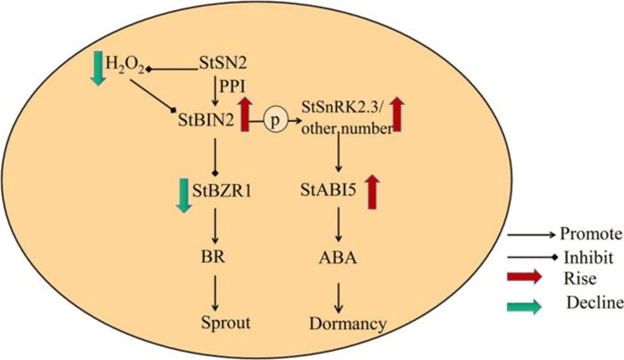For the potato industry, managing tuber dormancy is crucial to maintaining both the quality and longevity of stored potatoes. Dormancy, the natural phase that delays sprouting after harvest, is essential for preserving seed viability and ensuring potatoes remain market-ready. However, premature sprouting remains a significant challenge, causing post-harvest losses that impact farmers and producers worldwide.
Recent research from Sichuan Agricultural University, published in Horticulture Research on November 8, 2023, sheds new light on the molecular processes behind dormancy. Led by Dr. Xiyao Wang, the team’s study focused on the interaction between two proteins, StSN2 and StBIN2, and their role in extending potato tuber dormancy. These findings could lead to innovative storage strategies and, potentially, genetic improvements for better storage resilience.
The Role of StSN2 and StBIN2 in Dormancy Control
While previous research has identified key genes that influence dormancy, the complex molecular mechanisms have remained elusive. This study dives deeper, showing that the interaction between StSN2 and StBIN2 directly impacts tuber dormancy by regulating essential hormonal pathways.
- Mechanism Overview
The study demonstrates that StSN2, a dormancy-related protein, directly interacts with StBIN2, a protein that regulates brassinosteroid (BR) signaling, a plant hormone pathway known to influence growth and development. Through assays such as yeast two-hybrid tests and luciferase complementation, the researchers verified that StSN2 boosts StBIN2’s expression and activity, impacting dormancy through hormonal regulation. - Hormonal Pathway Regulation
In potatoes, the plant hormones abscisic acid (ABA) and brassinosteroids (BRs) are critical to maintaining dormancy. StSN2 and StBIN2 regulate ABA signaling, which helps prolong dormancy by activating SnRK2.2/2.3/2.6 and ABI5 genes, slowing down the sprouting process. Simultaneously, they inhibit BR signaling by suppressing the activity of StBZR1, a BR-signaling regulator that promotes growth. By enhancing ABA and reducing BR activity, these proteins together create a hormonal balance that extends dormancy. - Potential for Improved Storage
The study’s results showed that potatoes with overexpressed StSN2 and StBIN2 proteins had significantly prolonged dormancy periods. Mutagenesis experiments also pinpointed specific cysteine residues within StBIN2 that are critical to its interaction with StSN2, providing a potential target for future genetic manipulation.
Practical Applications for Potato Storage and Crop Management
The findings from this study offer practical implications for agriculture, especially in managing potato storage. With the ability to extend dormancy through controlled manipulation of the StSN2-StBIN2 interaction, farmers and storage managers could achieve better control over sprouting, potentially reducing the need for chemical sprout inhibitors.
- Storage Benefits
Extended dormancy could mean that potatoes remain viable in storage for longer periods, reducing post-harvest losses and improving supply chain efficiency. In regions where early sprouting leads to significant losses, this approach could have a considerable economic impact. The average potato storage loss due to sprouting in North America alone is estimated at over $150 million annually, a cost that could be reduced with better dormancy control. - Future Breeding Potential
The insights from this study also open doors for breeding programs focused on storage durability. By targeting the specific mechanisms behind dormancy, breeders could develop potato varieties that naturally retain quality longer, making them more resilient in storage without chemical treatments.
The discovery of the StSN2 and StBIN2 proteins’ interaction provides valuable insight into the genetic and hormonal controls of potato dormancy, marking a significant advancement in storage science. By harnessing these molecular mechanisms, the potato industry has new opportunities to enhance storage durability, reduce losses from sprouting, and even potentially develop new, storage-resilient potato varieties. This study underscores the vital role of molecular research in solving real-world agricultural challenges and highlights the potential benefits of integrating genetic approaches into crop management and storage practices.

